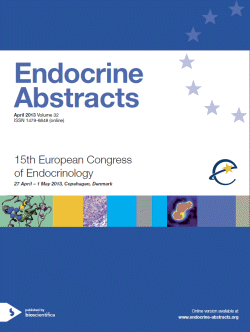Oral Communications
Reproduction
ea0032oc5.1 | Reproduction | ECE2013
BMP15-dependent gene-expression profiling in human granulosa cells
Rossetti Raffaella , Gentilini Davide , Beccaria Elena , Paffoni Alessio , Persani Luca
ea0032oc5.2 | Reproduction | ECE2013
The (TAAAA)n polymorphism in the SHBG gene is related to prenatal androgenization of female fetus: possible implications of the developmental origin of metabolic disorders
Pamporaki Christina , Xita Nectaria , Lazaros Leandros , Makridimas George , Georgiou Ioannis , kolios George , Plachouras Nikolaos , Tsatsoulis Agathocles
ea0032oc5.3 | Reproduction | ECE2013
Age-related hormonal and metabolic alterations in women with polycystic ovary syndrome (PCOS)
Pinola Pekka , Vanky Eszter , Sundstrom-Poromaa Inger , Stener-Victorin Elisabeth , Puurunen Johanna , Piltonen Terhi , Puukka Katri , Tapanainen Juha , Morin-Papunen Laure
ea0032oc5.4 | Reproduction | ECE2013
Influence of variants in the FSHB and FSHR gene on reproductive parameters in males and females
Gromoll Joerg , Schuring Andreas , Busch Alexander , Kliesch Sabine , Tuttelmann Frank
ea0032oc5.5 | Reproduction | ECE2013
FSHB −211 and FSHR 2039 polymorphisms are associated with serum levels of FSH, AMH and age of pubertal onset in 78 healthy girls: a longitudinal cohort study
Hagen Casper P , Aksglaede Lise , Sorensen Kaspar , Mouritsen Annette , Mieritz Mikkel G , Main Katharina M , Almstrup Kristian , Rajpert-De Meyts Ewa , Anderson Richard A , Juul Anders
ea0032oc5.6 | Reproduction | ECE2013
INSL3 in 268 male patients with congenital hypogonadotropic hypogonadism (CHH): effects of different modalities of hormonal treatment
Trabado Severine , Maione Luigi , Sarfati Julie , Salenave Sylvie , Chanson Philippe , Brailly-Tabard Sylvie , Young Jacques




